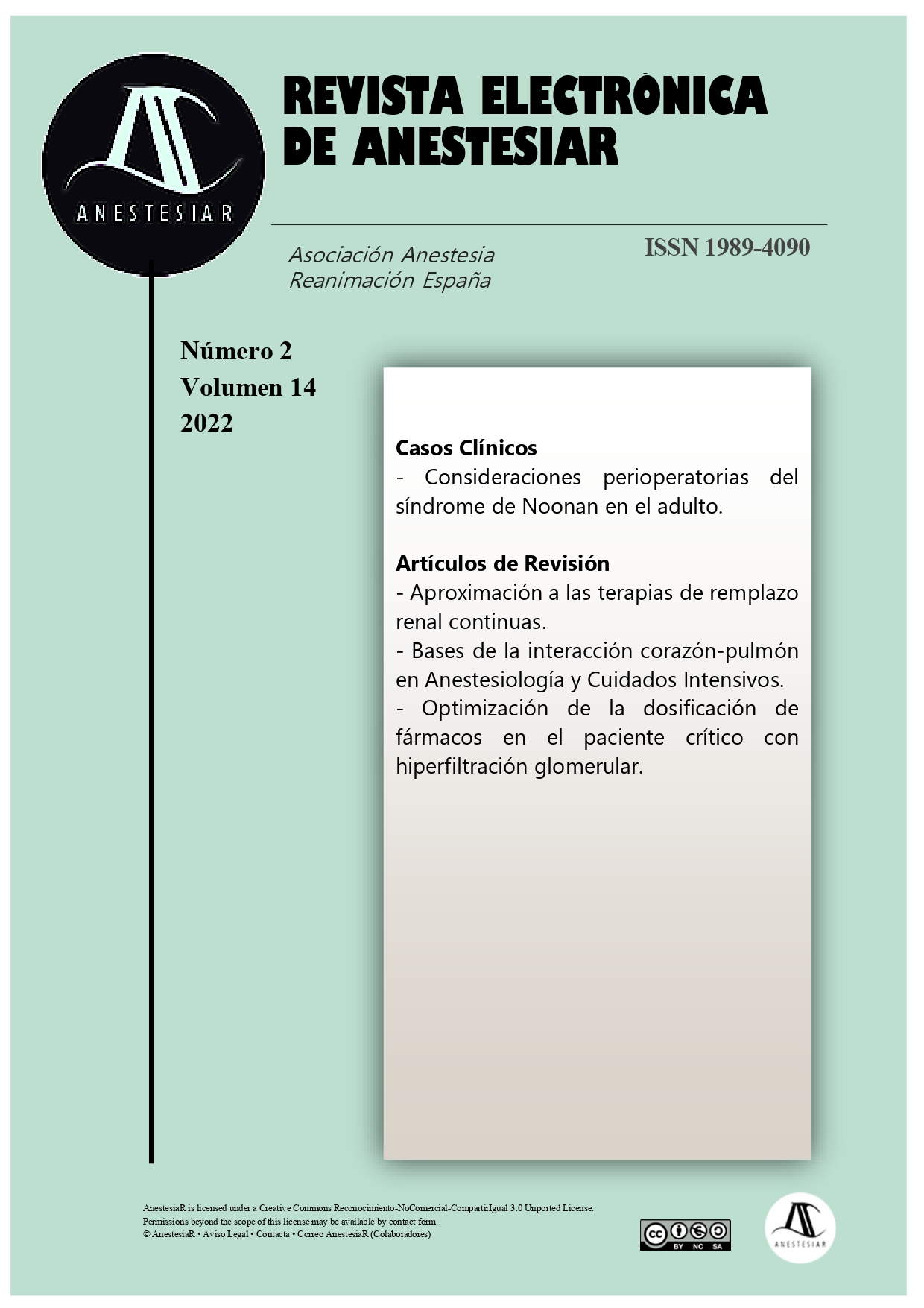Bases of the heart-lung interaction in Anesthesiology and Intensive Care.
DOI:
https://doi.org/10.30445/rear.v14i2.998Keywords:
Heart-lung interaction, Functional hemodynamic monitoring, Pulse pressure variation, Fluid responseAbstract
The interaction between the heart and the lungs is one of the basic rhythms of life and fluctuates with the rate of heartbeat and respiration. Knowledge of this set of mechanical, neural and humoral interactions is fundamental in the practice of Anesthesiology and Intensive Care. On the one hand, they are the basis of functional hemodynamic monitoring and help to understand its limitations, on the other, they allow a deeper understanding of the physiology of the critically ill patient and, especially, the effects of mechanical ventilation in patients with compromised cardiovascular reserve.
References
- Sette P, Dorizzi RM, Azzini AM. Vascular access: An historical perspective from Sir William Harvey to the 1956 Nobel prize to André F. Cournand, Werner Forssmann, and Dickinson W. Richards [Internet]. Vol. 13, Journal of Vascular Access. J Vasc Access; 2012 [cited 2020 Oct 20]. p. 137–44. Available from: https://pubmed.ncbi.nlm.nih.gov/21983826/
- Pinsky MR. Cardiopulmonary interactions: Physiologic basis and clinical applications. In: Annals of the American Thoracic Society. American Thoracic Society; 2018. p. S45–8.
- Paz-Martín D. REV ELECT ANESTESIAR-VOL 12 (6) :4 Análisis de la onda de presión arterial en Anestesiología y Cuidados Intensivos I. Rev Electrónica AnestesiaR [Internet]. 2020 Sep 10 [cited 2020 Nov 15];12(6):4–4. Available from: http://revistaanestesiar.org/index.php/rear/article/view/858
- Lansdorp B, Hofhuizen C, Van Lavieren M, Van Swieten H, Lemson J, Van Putten MJAM, et al. Mechanical ventilation-induced intrathoracic pressure distribution and heart-lung interactions. Crit Care Med. 2014;42(9):1983–90.
- Nanas S, Magder S. Adaptations of the peripheral circulation to PEEP. Am Rev Respir Dis [Internet]. 1992 [cited 2020 Oct 20];146(3):688–93. Available from: https://pubmed.ncbi.nlm.nih.gov/1519849/
- Pinsky MR. Instantaneous venous return curves in an intact canine preparation. J Appl Physiol Respir Environ Exerc Physiol [Internet]. 1984 [cited 2020 Oct 20];56(3):765–71. Available from: https://pubmed.ncbi.nlm.nih.gov/6368503/
- Chihara E, Hashimoto S, Kinoshita T, Hirose M, Tanaka Y, Morimoto T. Elevated mean systemic filling pressure due to intermittent positive- pressure ventilation. Am J Physiol - Hear Circ Physiol [Internet]. 1992 [cited 2020 Oct 20];262(4 31-4). Available from: https://pubmed.ncbi.nlm.nih.gov/1566893/
- Vieillard-Baron A, Matthay M, Teboul JL, Bein T, Schultz M, Magder S, et al. Experts’ opinion on management of hemodynamics in ARDS patients: focus on the effects of mechanical ventilation [Internet]. Vol. 42, Intensive Care Medicine. Springer Verlag; 2016 [cited 2020 Oct 20]. p. 739–49. Available from: https://link.springer.com/article/10.1007/s00134-016-4326-3
- West JB, Dollery CT, Naimark A. Ditribution of blood flow in isolated lung; Relation to vascular and alveolar pressures. J Appl Physiol. 1964;19:713–24.
- Marik PE, Cavallazzi R, Vasu T, Hirani A. Dynamic changes in arterial waveform derived variables and fluid responsiveness in mechanically ventilated patients: A systematic review of the literature [Internet]. Vol. 37, Critical Care Medicine. Lippincott Williams and Wilkins; 2009 [cited 2020 Oct 24]. p. 2642–7. Available from: https://pubmed.ncbi.nlm.nih.gov/19602972/
- Pinsky MR, Summer WR, Wise RA, Permutt S, Bromberger-Barnea B. Augmentation of cardiac function by elevation of intrathoracic pressure. J Appl Physiol Respir Environ Exerc Physiol [Internet]. 1983 [cited 2020 Oct 24];54(4):950–5. Available from: https://pubmed.ncbi.nlm.nih.gov/6853301/
- Jardin F, Farcot JC, Gueret P, Prost JF, Ozier Y, Bourdarias JP. Cyclic changes in arterial pulse during respiratory support. Circulation [Internet]. 1983 [cited 2020 Oct 24];68(2 I):266–74. Available from: https://pubmed.ncbi.nlm.nih.gov/6861305/
- Perel A, Pizov R, Cotev S. Systolic blood pressure variation is a sensitive indicator of hypovolemia in ventilated dogs subjected to graded hemorrhage. Anesthesiology [Internet]. 1987 Oct 1 [cited 2020 Oct 3];67(4):498–502. Available from: http://pubs.asahq.org/anesthesiology/article-pdf/67/4/498/315261/0000542-198710000-00009.pdf
- Michard F, Chemla D, Richard C, Wysocki M, Pinsky MR, Lecarpentier Y, et al. Clinical use of respiratory changes in arterial pulse pressure to monitor the hemodynamic effects of PEEP. Am J Respir Crit Care Med [Internet]. 1999 Mar 14 [cited 2020 Oct 26];159(3):935–9. Available from: http://www.atsjournals.org/doi/abs/10.1164/ajrccm.159.3.9805077
- Michard F, Boussat S, Chemla D, Anguel N, Mercat A, Lecarpentier Y, et al. Relation between Respiratory Changes in Arterial Pulse Pressure and Fluid Responsiveness in Septic Patients with Acute Circulatory Failure [Internet]. Vol. 162, Am J Respir Crit Care Med. 2000 [cited 2020 Oct 7]. Available from: www.atsjournals.org
- Hofer CK, Cecconi M, Marx G, Rocca G della. Minimally invasive haemodynamic monitoring. Eur J Anaesthesiol [Internet]. 2009 Dec [cited 2020 Oct 26];26(12):996–1002. Available from: http://journals.lww.com/00003643-200912000-00003
- Magder S, Brent G. Heart–lung interactions and pulmonary buffering: Lessons from a computational modeling study. Respir Physiol Neurobiol. 2012;182(2–3):60–70.
- Teboul JL, Saugel B, Cecconi M, De Backer D, Hofer CK, Monnet X, et al. Less invasive hemodynamic monitoring in critically ill patients. Intensive Care Med. 2016;42(9).
- Liu Y, Lou J, Mi W, Yuan W, Fu Q, Wang M, et al. Pulse pressure variation shows a direct linear correlation with tidal volume in anesthetized healthy patients. 2016 [cited 2020 Oct 15]; Available from: www.clinicaltrials.gov,
- HØISETH LØ, HOFF IE, MYRE K, LANDSVERK SA, KIRKEBØEN KA. Dynamic variables of fluid responsiveness during pneumoperitoneum and laparoscopic surgery. Acta Anaesthesiol Scand [Internet]. 2012 Jul 1 [cited 2020 Dec 4];56(6):777–86. Available from: http://doi.wiley.com/10.1111/j.1399-6576.2011.02641.x
- Zlicar M, Novak-Jankovic V, Blagus R, Cecconi M. Predictive values of pulse pressure variation and stroke volume variation for fluid responsiveness in patients with pneumoperitoneum. J Clin Monit Comput [Internet]. 2018 Oct 1 [cited 2020 Dec 4];32(5):825–32. Available from: https://pubmed.ncbi.nlm.nih.gov/29149433/
Downloads
Published
How to Cite
Issue
Section
License
Copyright (c) 2022 Revista Electrónica AnestesiaR

This work is licensed under a Creative Commons Attribution-ShareAlike 4.0 International License.
 Envío y derechos de autor
Envío y derechos de autor


 Revista Electrónica AnestesiaR by
Revista Electrónica AnestesiaR by 